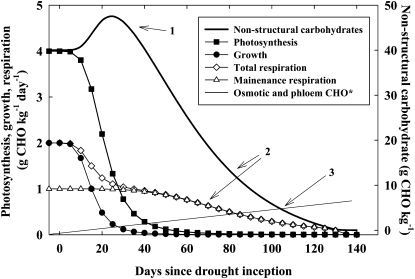Figure 1.
Simulated effects of prolonged drought on total NSC content, photosynthesis, growth, and respiration of a generic tree. The model summarizes the general relationships among these carbon pools and fluxes; it is not intended to mimic any particular circumstance. Arrow 1, Based on experimental observations that growth is most sensitive to water stress, followed by photosynthesis, and finally respiration, the carbohydrate pool initially increases. Only after photosynthesis declines to a rate slower than respiration do carbohydrates decline. Arrow 2, Growth respiration becomes minimal and hence respiration is only for maintenance. If maintenance respiration increases with drought and high temperatures, the size of the carbohydrate pool might decline more rapidly (Supplemental Fig. S2). Arrow 3, The simulated NSC pool implicitly includes noncarbohydrate organic compounds such as Pro that can accumulate during drought but does not account for NSC utilization for osmotic adjustment or maintenance of phloem transport. A linear increase in carbohydrate (CHO) consumption is shown for demonstrative purposes (asterisk). The intercept point of NSC with the NSC required to maintain turgor is a hypothetical mortality threshold in the absence of attack by biotic agents. See Supplemental Data for a fuller description of the model.

